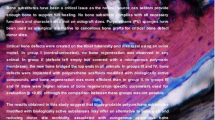Abstract
Functional and three-dimensional reconstruction of lost or deformed body parts is the main aim of plastic surgery. Many techniques can and have been used for this purpose. Prefabrication can be used to reduce donor site morbidity. Although prefabrication reduces donor site morbidity, it usually requires multistage operations especially for composite defects. We report the prefabrication of two different implants in one stage using high-density porous polyethylene and acellular dermal matrix in rats, since these materials do not require an immediate blood supply. Before surgery, a high-density porous polyethylene layer and a 2 × 1cm acellular dermal matrix were prepared and sutured to each other. The femoral artery, vein, and nerve were used as a pedicle. The pedicle was placed and anchored underneath the implants; in order to prevent neovascularization from another source, this complex was wrapped in a silicone sheet. A total of ten implants were prefabricated. Six weeks after the surgery, the implants were evaluated macroscopically and histologically. Macroscopic and histological examinations showed that two different implants could be prefabricated in one stage for composite defects.





Similar content being viewed by others
References
Ozdemir R, Kocer U, Tiftikçioğlu YO et al (2005) Axial pattern composite prefabrication of high-density porous polyethylene: experimental and clinical research. Plast Reconstr Surg 115(1):183–196
Can Z, Erçöçen AR, Apaydın I et al (2000) Tissue engineering of high-density porous polyethylene implant for three-dimensional reconstruction: an experimental study. Scand J Plast Reconstr Surg Hand Surg 34:9–14
Nathan DS (2002) Implants, soft tissue, alloderm. http://www.emedicine.com/ent/topic733.htm.June 20
Gore DC (2005) Utility of acellular dermis in the care of elderly burn patients. J Surg Res 125(1):37–41
Agag RL, Granick MS, Omidi M et al (2004) Neurosurgical reconstruction with acellular cadaveric dermal matrix. Ann Plast Surg 52(6):571–577
Butler CE, Prieto VG (2004) Reduction of adhesions with composite alloderm/polypropylene mesh implants for abdominal wall reconstruction. Plast Reconstr Surg 114(2):464–473
Kostakoğlu N, Manek S, Green CJ (1997) The development of neovascularization in flap prefabrication with vascular implantation: an experimental study. Br J Plast Surg 50:428–434
Tezel E, Numanoğlu A, Bayramiçli M et al (2000) Fat prefabrication using a fascial flap in the rat model. Br J Plast Surg 53:155–160
Tark KC, Chung S, Shin KS et al (2000) Skin flap prefabrication using acellular dermal matrix an cultured keratinocytes in a porcine model. Ann Plast Surg 44(4):392–397
Ozdemir OM, Serel S, Gokrem S et al (2004) Three-dimensional orthotopic reconstruction with a free, prefabricated high-density porous polyethylene implant flap. Turk J Trauma Emerg Surg 10(2):75–82
Yaremchuk MJ (2003) Facial Skeletal reconstruction using porous polyethylene implants. Plast Reconstr Surg 111(6):1818–1827
Niechajev I (1999) Porous polyethylene implants for nasal reconstruction: clinical and histologic studies. Aesthet Plast Surg 23:395
Castor SA, To WC, Papay FA (1999) Lip augmentation with Alloderm acellular allogenic dermatofat autograft: a comparison with autologous fat injection alone. Aesthet Plast Surg 23(3):218–223
Jones FR, Schwartz BM, Silverstien P (1996) Use of a non-immunogenic acellular dermal graft for soft tissue augmentation: a preliminary report. Aesthet Surg J 16:196–201
Kridel RW, Foda H, Lunde KC (1998) Septal perforation repair with acellular human dermal allograft. Arch Otolaryngol Head Neck Surg 124(1):73–78
Papel ID, Mabrie DC (1999) Deprojecting the nasal profile. Otolaryngol Clin North Am 32(1):65–87
Romo T 3rd, Sclafani AP, Falk AN et al (1999) A graduated approach to the repair of nasal septal perforations. Plast Reconstr Surg 103(1):66–75
Sheridan R, Choucair R, Donelan M et al (1998) Acellular allodermis in burns surgery: 1-year results of a pilot trial. J Burn Care Rehabil 19(6):528–530
Silverstein P (1997) Depressed scar revision: lifecell clinical case summary. LifeCell, Houston
Author information
Authors and Affiliations
Corresponding author
Rights and permissions
About this article
Cite this article
Serel, S., Uluç, A., Kaya, B. et al. One-stage prefabrication for composite tissue defects including two different tissue layers using high-density porous polyethylene and acellular dermal matrix. Eur J Plast Surg 31, 315–319 (2008). https://doi.org/10.1007/s00238-008-0275-6
Received:
Accepted:
Published:
Issue Date:
DOI: https://doi.org/10.1007/s00238-008-0275-6




